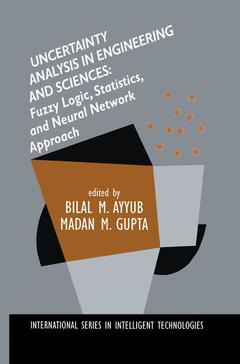Uncertainty Analysis in Engineering and Sciences: Fuzzy Logic, Statistics, and Neural Network Approach, Softcover reprint of the original 1st ed. 1998 International Series in Intelligent Technologies Series, Vol. 11
Langue : Anglais
Coordonnateurs : Ayyub Bilal M., Gupta Madan M.

Uncertainty has been of concern to engineers, managers and . scientists for many centuries. In management sciences there have existed definitions of uncertainty in a rather narrow sense since the beginning of this century. In engineering and uncertainty has for a long time been considered as in sciences, however, synonymous with random, stochastic, statistic, or probabilistic. Only since the early sixties views on uncertainty have ~ecome more heterogeneous and more tools to model uncertainty than statistics have been proposed by several scientists. The problem of modeling uncertainty adequately has become more important the more complex systems have become, the faster the scientific and engineering world develops, and the more important, but also more difficult, forecasting of future states of systems have become. The first question one should probably ask is whether uncertainty is a phenomenon, a feature of real world systems, a state of mind or a label for a situation in which a human being wants to make statements about phenomena, i. e. , reality, models, and theories, respectively. One cart also ask whether uncertainty is an objective fact or just a subjective impression which is closely related to individual persons. Whether uncertainty is an objective feature of physical real systems seems to be a philosophical question. This shall not be answered in this volume.
1. The Role of Constrained Fuzzy Arithmetic in Engineering.- 2. General Perspective on the Formalization of Uncertain Knowledge.- 3. Distributional Representations of Random Interval Measurements.- 4. A Fuzzy Morphology: a Logical Approach.- 5. Reliability Analysis with Fuzziness and Randomness.- 6. Fuzzy Signal Detection with Multiple Waveform Features.- 7. Uncertainty Modeling of Normal Vibrations.- 8. Modeling and Implementation of Fuzzy Time Point Reasoning in Microprocessor Systems.- 9. Model Learning with Bayesian Networks for Target Recognition.- 10. System Life Cycle Optimization Under Uncertainty.- 11. Valuation-Based Systems for Pavement Management Decision Making.- 12. Hybrid Least-Square Regression Analysis.- 13. Linear Regression with Random Fuzzy Numbers.- 14. Neural Net Solutions to Systems of Fuzzy Linear Equations.- 15. Fuzzy Logic: A Case Study in Performance Measurement.- 16. Fuzzy Genetic Algorithm Based Approach to Machine Learning Under Uncertainty.- 17. Recurrent Neuro-Fuzzy Models of Complex Systems.- 18. Adaptive Fuzzy Systems with Sinusoidal Membership Functions.- 19. A Computational Method for Fuzzy Optimization.- 20. Interaction of Fuzzy Knowledge Granules for Conjunctive Logic.- 21. Fuzzy Decision Processes with Expected Fuzzy Rewards.- 22. On the Computability of Possibilistic Reliability.- 23. Distributed Reasoning with Uncertain Data.- 24. A Fresh Perspective on Uncertainty Modeling: Uncertainty vs. Uncertainty Modeling.- About the Editors.
Uncertainty Analysis in Engineering and Sciences: Fuzzy Logic, Statistics, and Neural Network Approach examines the use of newly developed analytical tools for studying uncertainty analysis in engineering, control systems, and the sciences. It is the work of 38 experts who have written chapters on newly developed analytical methods -- fuzzy logic, neural networks, simulation, and Bayesian techniques -- and have applied them to uncertainty phenomena arising out of information and knowledge problems in the fields of engineering and the sciences. The book is divided into the following parts: Part I reports the theoretical studies on uncertainty types, models and measures, Part II reviews the applications of uncertain theoretical tools to engineering systems, Part III describes the methodolog
Date de parution : 10-2012
Ouvrage de 371 p.
15.5x23.5 cm
© 2024 LAVOISIER S.A.S.



